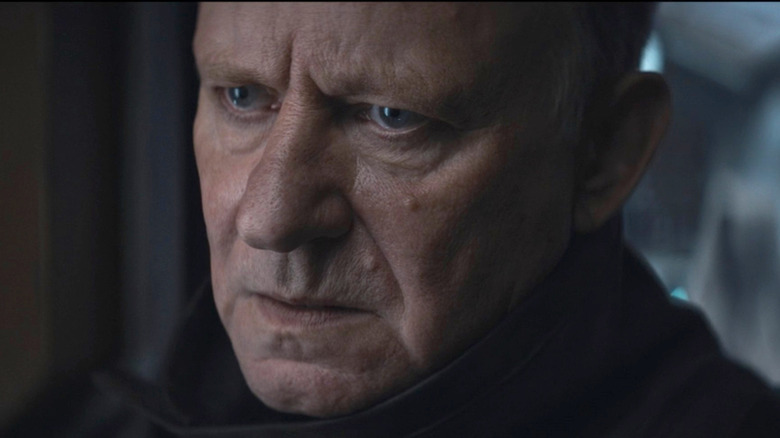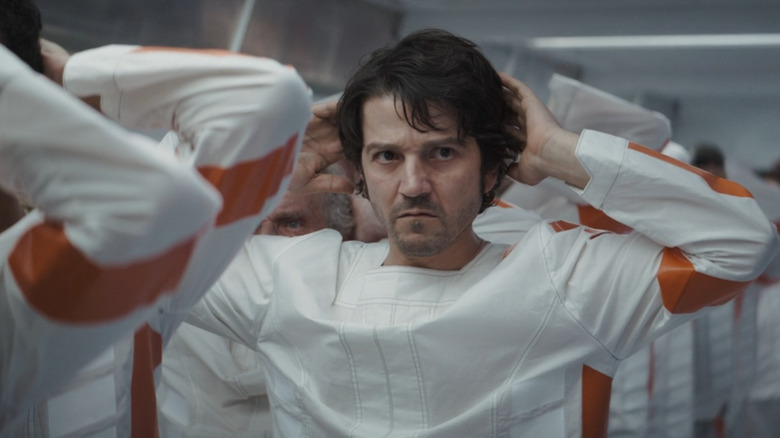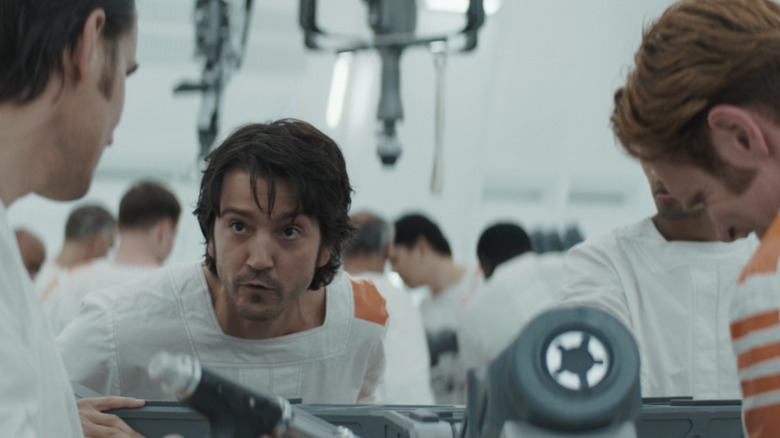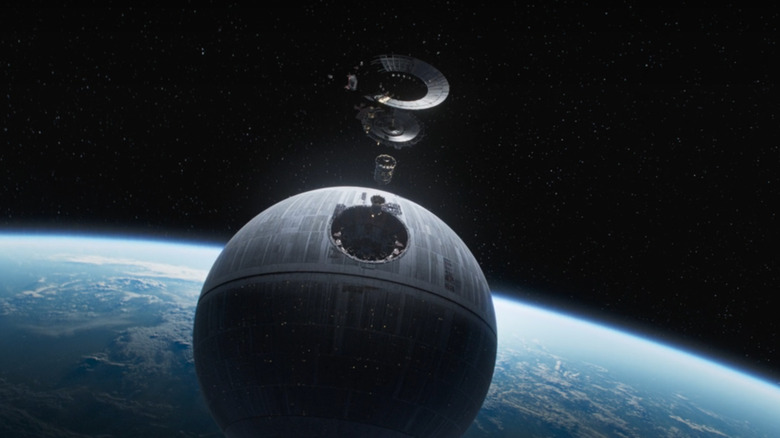The Dark Reveal In Andor's Post-Credits Scene Answers An Age-Old Star Wars Mystery
Disney's "Andor" occupies a special place in the "Star Wars" timeline. The prequel movies, ending with "Revenge of the Sith," sees the bureaucratic Galactic Republic corrupted and taken over from within by an individual using emergency rules and parliamentary edicts designed to consolidate power. Of course by the time "Star Wars: A New Hope" comes around, the Republic has been replaced by the Empire, which uses fear tactics and overwhelming firepower to suppress dissent. The most infamous example of this is the Death Star, a massive space structure capable of destroying planets and being occasionally mistaken for moons.
"Andor" is nestled in the time before the original "Star Wars" trilogy and after the prequels. "Andor" itself is a prequel to "Rogue One: A Star Wars Story," which sees Cassian Andor (Diego Luna) and Jyn Erso (Felicity Jones) make a faithful sacrifice in order to deliver the plans for the Death Star to the Rebel Alliance, and the movie pretty much ends exactly where "A New Hope" picks up — with Darth Vader (James Earl Jones) pursuing the ship of Princess Leia (Carrie Fisher). Now that "Andor" has completed its first season, the ending stinger helps bring a greater focus to this era of "Star Wars" history, and it certainly gives Cassian a very specific reason to hate the Empire and its superweapons.
Cassian is sent to an Imperial prison where he helps build the Death Star
"Andor" starts with small enough stakes, as Cassian looks for any clues to the location of his long-lost sister on the planet of Morlana One. Unfortunately, he is shaken down by two security officers, which results in Cassian killing both. This starts off a localized hunt for Cassian, though soon the Empire gets involved when it is revealed that Cassian had access to an Imperial Starpath Unit — an exceptionally hard-to-get item that would allow one to track Imperial vessels. Although Cassian wants nothing to do with rebels, he accepts a job on Aldhani which involves stealing the Imperial payroll for an entire sector.
Completing his task, Cassian receives his massive payday and decides to lay low. Unfortunately, Imperial forces are engaged in a galaxy-wide crackdown, and he is charged as a vandal even though he is innocent. Given a six-year prison sentence, Cassian is sent to Narkina 5, an Imperial prison and industrial complex. Forced to work on some unknown project, Cassian and his fellow inmates are kept in line by an electrified floor. Eventually, it becomes known that none of the prisoners are getting a chance to leave, even after their sentences are up, which causes Cassian to organize a successful escape. Two episodes later and after a bombastic finale, it is finally revealed what Cassian and his fellow inmates were working on: the original Death Star.
The prison industrial complex helps explain how the Death Star is constructed
This stinger post-credits scene at the end of the first season of "Andor" establishes just how the Empire is able to create its fearsome planet-destroying weapon. By utilizing prisoners that may or may not be innocent, the Empire is able to create a workforce that cannot complain, quit, leave, or even tell others what they are working on, which would endanger the Empire's doctrine of ruling through secrets and fear.
As noted by The Sun, the original Death Star measures around 75 miles wide, which for the math-inclined, results in a volume of 32,515,031,575,312,243 cubic feet. These numbers certainly illustrate just how much effort had to go into the clandestine project and how long the Empire had been working on the planet-killer. It is also important to remember that the original design for the Death Star came from the Geonosians during the events of "Attack of the Clones."
Another aspect to consider involving the construction of the Death Star is that by the Empire utilizing prisoner labor, they are able to harness a tremendous amount of labor that the Empire doesn't need to worry about talking. This is probably another reason why none of the other prisoners on Narkina 5 are allowed to leave — the Empire doesn't want to risk anybody putting together what their project is. This makes sense, considering that planet-killing weapons are probably a tough sell to all but the most stringent of Imperial supporters and citizens.
The Andor showrunner said this plot point was decided earlier on
This reveal, although currently unknown to Cassian, certainly helps to establish some of his motivation in "Rogue One." Cassian, throughout Season 1 of "Andor," certainly isn't committed to the Rebel Alliance cause. He simply wants to get paid, settle his debts, find his sister, and be left in peace. Though he doesn't love the Empire in any sense, he certainly isn't trying to take down the oppressive regime. Of course, by the time Season 2 rolls around, Cassian will be much more dedicated to the cause, especially considering what his adoptive mother Maarva (Fiona Shaw) said in a recorded message after her death.
The teaser scene featuring droids putting the Death Star together at the end of "Andor," and the fact that Cassian had been working on the Death Star the entire time was something that the series had always been building towards. Speaking with Polygon, showrunner Tony Gilroy said, "We came up with the prison, and the building of the part, pretty early on. It was like, 'Oh, they should be building the Death Star.' And then, you know, you follow it forward, and it's like, 'Oh, you know what? We oughta show that.' So the visual effects department just loved that idea. And they ran with it." Still, it will be interesting to see where Season 2 of "Andor" leads, and how much Cassian will change over the upcoming course of events before the events of "Rogue One."



